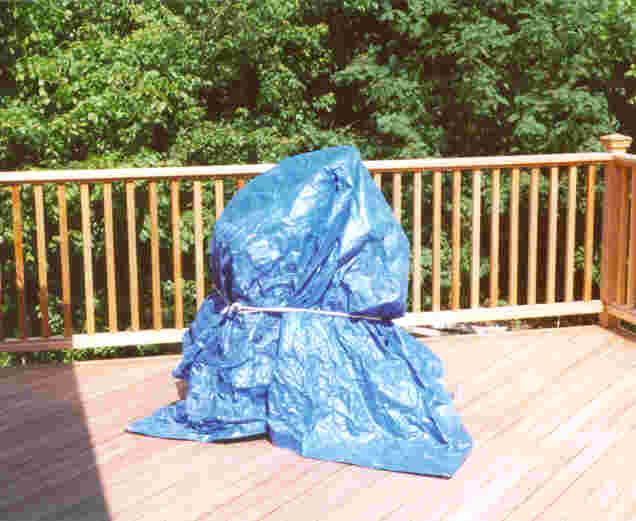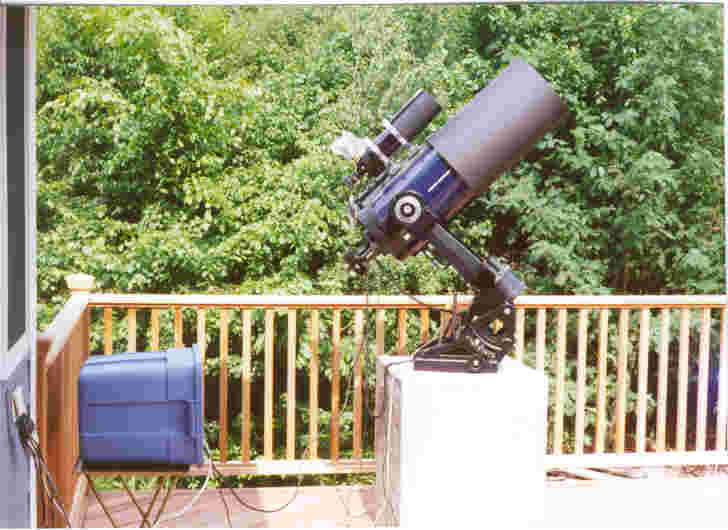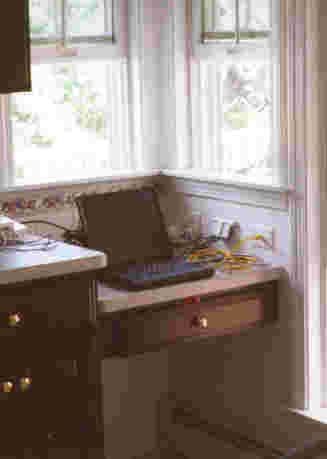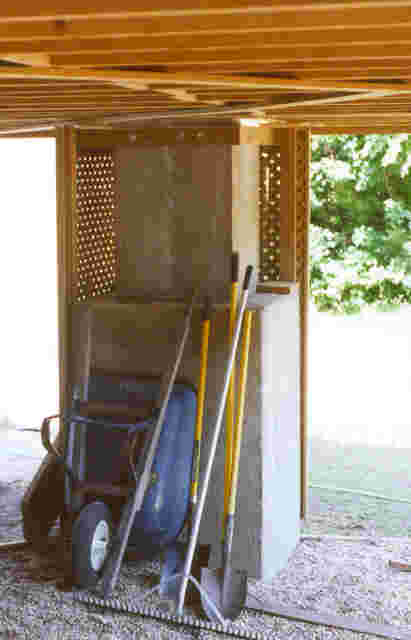
I have had no problems with water on the wedge or the top of the pier. It provided protection in the snow of winter and the winds of spring. It works like a wonder.
When my wife wanted to expand the kitchen, I was able to convince her that
I should have a 'permanent' place for my telescope. Since I like to do CCD
Astronomy, I wanted the permanent solution to be close enough to the house so
I can enjoy CCD'ing in comfort. The solution was a concrete pedestal. I can
mount a wedge on the pedestal and, once aligned initially, be very close from night
to night so that I do not need to align every observing session.
As a result, we added a pier that passed through our deck. Because the deck is
up one floor, the pier is about twelve feet out of the ground. We have taken
to calling it the 'Obelisk'.
I had initially pictured a footing in the ground (about 3' x 3') and a 10"
diameter sonotube. However, once the project engineer and contractor got
into the act the pier has a 6' x 6' x 2' footer, a lower section that
is 3' x 3' x 10', and an upper section that is 2' x 2' x 6'. This turned into
7 tons of concrete and 500 lbs of reinforcing steel.
The pier is very stable and is isolated from the deck and its supports. Walking
on the deck while observing produces no noticable effects. While observatory
is an overdescription of this facility, it provides a quick way to get ready
for observing sessions. From the decision to observe to ready to image is about 15
minutes. For visual work it is less than five minutes.
The wedge was installed on December 31, 1998. Most of the images on the site
taken since that time are from this location.

|
This is the 'observatory' in its closed position. The tarp covers the
wedge and the top of the pier. I use rope and a bungee cord to secure the
tarp over the top. This is the white horizontal line on the blue tarp.
I have had no problems with water on the wedge or the top of the pier. It provided protection in the snow of winter and the winds of spring. It works like a wonder. |

|
This is the observatory in its 'open' position. The wedge is a Meade Superwedge. |

|
This is the outside part of the setup for CCD astronomy. The telescope is
a Meade LX200 10" F/6.3. Using Milburn rings, I have an ETX piggybacked
on to it for guiding. A Pictor 201xt is attached to the ETX for guiding.
Pictured is a Pictor 416xt for imaging. There is an electric focusser on
the telescope.
To the left is a Rubbermaid storage container that contains the base unit for the Pictorview. The container doubles as storage for the 416, 201, ETX, hand controller, ETX dew shield, and adapters when not observing. The container is sitting on a TV table. To the very left, on the wall of the house below the window is a 'pass through' for the power wires for the two CCD cameras and the telescope, for the SCSI cable for the interface to the Pictor, and for the RS-232 cable to the LX200. The black and white connecter hanging there is the end of the contector for the 1460A adapter and the end of a 2 meter SCSI cable. |

|
This is from the inside of my wife's kitchen. She has allowed me one corner
for my astronomy activities. The desk doubles for her use if it is not clear.
You can see the laptop I use for CCD imaging. To its right is the 'pass through' for the cables to outside. I stuff a rag in the opening to prevent unwanted creatures from using this as an entrance to the house. The cover on both the inside and the outside are electral outlet covers which provide a good weather seal. The rag is just extra protection, particularly when the flaps are proped open like they are when being used. To the right of the 'pass through' is a LAN connector (shown with a yellow cable connected to the laptop). This provides access to the Internet from the laptop (so I can check mail and net surf) and allows me to access the laptop's data from my main desktop system. Though the window above the 'pass through' you can see the telescope. |

|
This is the underneath of the 'observatory'. You can see the step from a 3' x 3' cross section to a 2' x 2' cross section. You can see the lattice work my wife insisted to 'hide' the Obelisk. My contractor thinks it is a great place to store his equipment. |